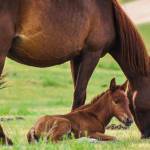Supplemental Niacin May Improve Mare Fertility

Schoolchildren often encounter the word “niacin” innocently enough, as they lean over a breakfast bowl, spoon in hand, and read the packaging of their favorite cereal. Although time wears on and science classes pile on top of one another, they may learn little else about this particular B vitamin and its importance to their health.
Likewise, little is known about the dietary requirements of niacin in the horse, with researchers concluding that a robust microbial population in the hindgut manufactures enough of it and other B vitamins to satisfy requirements, in addition to any it may consume as part of its diet. In the late 1990s, two trials in exercising Thoroughbred horses showed that neither acute nor chronic niacin supplementation, at a rate of 3 g per day, affected exercise metabolism or niacin status.*
In a recent study, though, researchers took aim at a different segment of the equine population: broodmares, as other scientists had discovered a link between niacin deficiency and congenital malformations in humans and embryonic death and resorption in mice.+,○ Because mares suffer from high rates of early embryonic loss, the objective of this preliminary study was to examine the absorption and metabolism of niacin in mares to determine its potential use to support early embryonic health and to improve pregnancy outcomes.
Researchers orally supplemented four mares with 5 g of niacin mixed into applesauce. Blood was collected at specific time points: 0, 0.25, 0.5, 1, 2, 4, 6, and 22 hours after administration. Plasma was extracted and niacin metabolites were analyzed by mass spectrometry.
According to the researchers, the results revealed that “a significant amount of the supplemental niacin was absorbed and present in circulating blood following ingestion. Metabolites were present in plasma at concentrations high enough to exert biological effects following distribution to cells.”
Follow-up studies are necessary to determine the effects of niacin supplementation on the ovarian follicular environment of the mare, oocyte quality, and pregnancy outcome, as well as to determine urine excretion of metabolites.
In regard to broodmares, optimal nutrition and optimal body condition are necessary for reproductive performance. Optimal nutrition can be defined as providing all of the essential nutrients for health in appropriate amounts, while optimal body condition can be defined as provision of sufficient energy for maintenance of moderate weight.
Mares should be in moderate to moderately fleshy body condition when presented to breed. This equates to a body condition score of 5 or 6. Studies have shown that mares with a body condition below 4 might stay in anestrus longer the mares in moderate condition, and mares with a body condition less than 4.5 have decreased pregnancy rates.
*Parker, A.L, L.M. Lawrence, S. Rockuroda, et al. 1997. The effects of niacin supplementation on niacin status and exercise metabolism in horses. In: Proceedings of the 15th Equine Nutrition and Physiology Society, p. 19.
+Pollard, C.L., Z. Gibb, A. Swegen, E. Lawson, and C.G. Grupen. 2020. Niacin as a dietary supplement for improving mare fertility: A preliminary pharmacokinetic study. Journal of Equine Veterinary Science 89 (Abstract).
○Shi, H., A. Enriques, M. Rapadas, E.M.M.A. Martin, et al. 2017. NAD deficiency, congenital malformations, and niacin supplementation. The New England Journal of Medicine 377:544-552.








